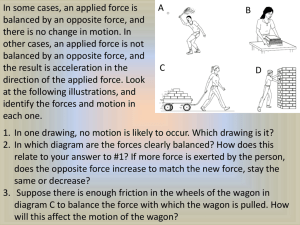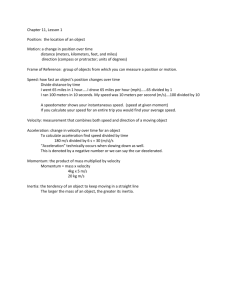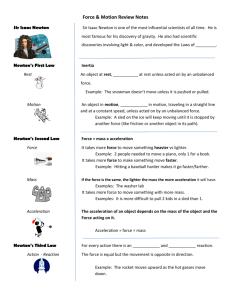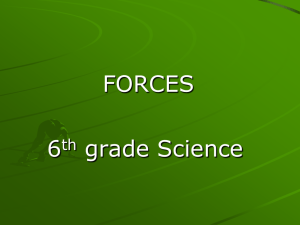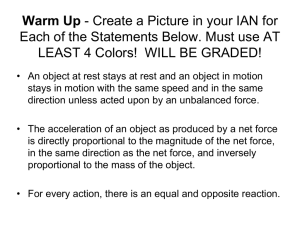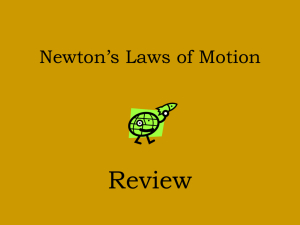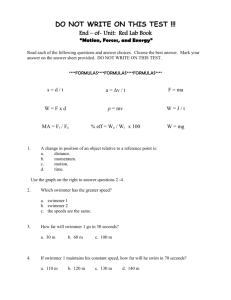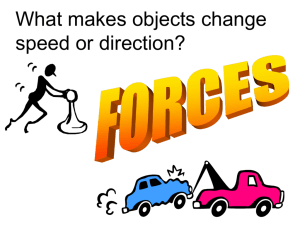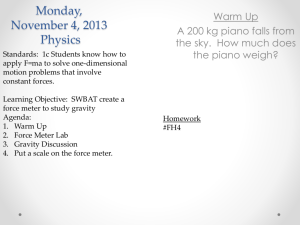Force and Motion: 7th Grade Curriculum Guide
advertisement
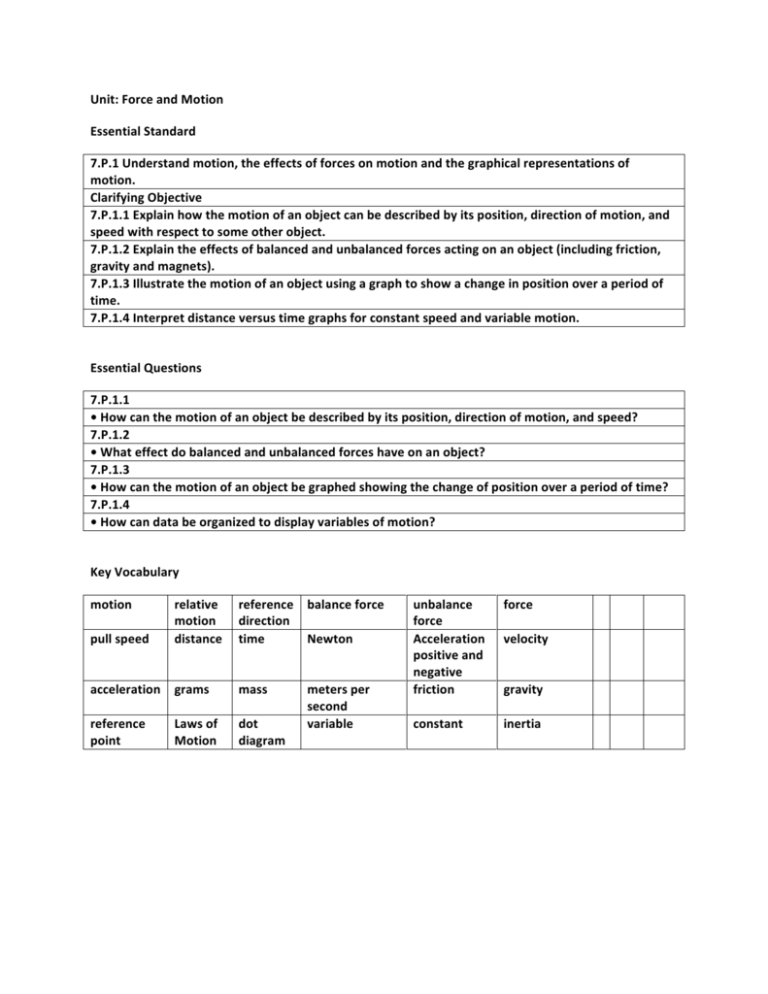
Unit: Force and Motion Essential Standard 7.P.1 Understand motion, the effects of forces on motion and the graphical representations of motion. Clarifying Objective 7.P.1.1 Explain how the motion of an object can be described by its position, direction of motion, and speed with respect to some other object. 7.P.1.2 Explain the effects of balanced and unbalanced forces acting on an object (including friction, gravity and magnets). 7.P.1.3 Illustrate the motion of an object using a graph to show a change in position over a period of time. 7.P.1.4 Interpret distance versus time graphs for constant speed and variable motion. Essential Questions 7.P.1.1 • How can the motion of an object be described by its position, direction of motion, and speed? 7.P.1.2 • What effect do balanced and unbalanced forces have on an object? 7.P.1.3 • How can the motion of an object be graphed showing the change of position over a period of time? 7.P.1.4 • How can data be organized to display variables of motion? Key Vocabulary motion pull speed relative reference balance force motion direction distance time Newton acceleration grams mass reference point dot diagram Laws of Motion meters per second variable unbalance force Acceleration positive and negative friction force velocity gravity constant inertia Acceleration Acceleration = Force/Mass; m/s2, or m/s/s acceleration of gravity on earth 9.8 m/s2 Average acceleration AA = final velocity -­‐ initial velocity/Time; m/s2 or m/s/s Average speed AS = total distance/total time; Meters/second, etc. Balanced forces there is no force at all centripetal force has the force pointing towards the center of the circle. Distance Distance = speed x time; meters centimeters, miles, etc. Force Force = mass x acceleration; Newtons Newton is a (Kg x m/s2) Force and motion.... determine acceleration Forces can change... direction. Moving at a constant speed but accelerating. mass is a measure of .... Inertia. It is related to mass. Newton's First Law Relates force and motion. (Law of Inertia) Newton's Second Law of Motion relates force, mass and acceleration Newton's Third Law of Motion For every ACTION there is an equal but opposite REACTION. Power Power = force x distance/time; Joules/second *Remember, a J/s is a Watt (W) Power Power = Work/Time; Joules/second *Remeber, a J/s is a Watt(W) Speed Speed = Distance/time; Meters/second, etc. Learning Target (“I can…”) and Learning Outcomes (“I will…”) 7.P.1.1 • I can explain how motion of an object can be described by its position, direction and speed. • I will explain position in relation to reference points. • I will describe how an object’s position changes based on variables of motion • I will calculate the speed of an object using the formula “Speed= Distance/Time” 7.P.1.2 • I can analyze the effects of forces acting on objects. • I will analyze the poles of a magnet and understand how they generate balanced and unbalanced forces • I will describe how objects at rest resist a change in their position or direction of motion. • I will describe how objects in motion resist a change in their position. • I will use my knowledge of forces and inertia to analyze how an object moves. • I will define force including: friction, gravity, and magnetism) • I will classify which forces are at work in a given situation such as: balanced, unbalanced, action-­‐reaction pairs. • I will create examples of real life situations where forces are at work • I will describe how changes in velocity, acceleration, and speed affect motion 7.P.1.3 • I can collect data and use the information to graph change in position over time. • I will observe an object over time to collect and organize data • I will use my understanding of distance and time to infer an object’s change in motion • I will create a graph using the data collected to illustrate the motion of an object 7.P.1.4 • I can interpret a time versus distance graph for constant speed and variable motion. • I will draw conclusions based on prepared graphs and collected data. • I will analyze the prepared graphs and determine changes in motion. Literacy Connections R.7.4: Determine the meaning of symbols, key terms, and other domain-­‐specific words and phrases as they are used in specific scientific context. R.7.6L Analyze the author's purpose in providing an explanation, describing a procedure, or discussing an experiment in a text. R.7.7: Integrate quantitative or technical information expressed in words in a text with a version of that information expressed visually (e.g., in a flow chart, diagram, model, graph or table). R.7.8: Distinguish among facts, reasoned judgment based on research findings, and speculation in a text. R.7.9: Compare and contrast the information gained from experiments, simulations, video, or multimedia sources with that gained from reading a text on the same topic.17 Assessments • Chapter/Unit Tests • Section/Chapter Review • Standardized Test Practice • Class Labs • Lab Generator • Test Generator • Content Review CD-­‐ROM • Section Quizzes • Diagnostic Test • Unit Projects • Alternative Assessment Possible Crosscutting Practices • Discuss proportional relationships and ratios (e.g. speed is a ration of distance travel to time taken.) • Apply Newtons Third Law to design a solution to a problem involve the motion of two colliding objects. An example could include proposing a solution to the impact of collisions between two cars.) • Ask questions about data to determine the strength of electrical forces. An example could include the effect of the number of turns of wire on the strength of an electromagnet. • Construct and defend an argument to support a claim related to gravitational interactions or exertion of forces on objects. Examples could include using Vernier tools to investigate forces between objects. Additional Notes on Unit Note, Newton’s Laws should not be memorized at this age. Rather, the principles which underpin the laws
